True to Their School
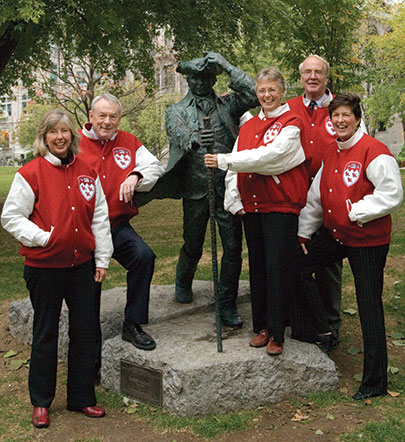
McGill Alumni Association presidents, past and present. From left to right: current MAA president Ann Vroom, BA’67, Richard Pound, BCom’62, BCL’67, Sally McDougall, BSc’68, Dip Ed’69, Robert Faith, BA’53, DDS’58, and Morna Flood Consedine, DipEd’71, MEd’77, DEd’85.
Nicolas Morin
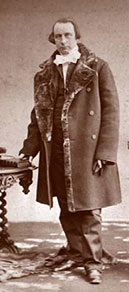
Principal William Dawson
William Notman/McCord Museum
William Dawson was a principal with a problem. His university, quite literally, was a mess.
Surveying his campus, Dawson, who became McGill's fifth principal in 1855, had ample cause for dismay. The new Arts Building was badly damaged by a hail of rocks, courtesy of dynamiting taking place at the nearby McTavish Reservoir. The ruins stood, as Dawson wrote, "amidst a wilderness of excavators' and masons' rubbish, overgrown with weeds and bushes."
Dawson watched wearily as the cows contentedly grazed on McGill's unfenced grounds. The school wouldn't attract new students if it resembled, as he put it, "a common, used for pasturage." Even back then, before universities had to compete fiercely for faculty and students, Dawson understood the importance of appearance. His campus badly needed a makeover.
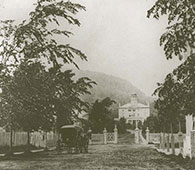
McGill circa 1850s
McGill University Archives
The new principal and avid naturalist decided that enough was enough, and rolled up his sleeves to begin planting trees. The saplings would grow and provide clear, natural markings of the lower campus grounds.
Dawson didn't dig alone. Planting alongside him were members of what would become the McGill Alumni Association (MAA). The fledgling organization's trademark devotion to the University was evident right from the start.
The ties that bind
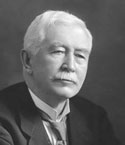
Thomas Roddick
McGill University Archives
"There is some kind of magic, that's all I can say, about McGill alumni. There is a loyalty here, and an enthusiasm for this institution that almost defies definition," says Ann Vroom, BA'67, president of the MAA. "They have been, and continue to be, the envy of other institutions — certainly in Canada."
The source of that loyalty can be difficult to pin down.
"We're not a tiny university, but it's the kind of bond that you would expect from a smaller university where students live on campus and form very tight-knit circles," notes Vroom. "In this position I've travelled a fair bit, and certainly you find that the connection alumni feel is even stronger the farther you get away from Montreal."
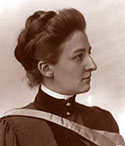
Carrie Derick
McGill University Archives
Honora Shaughnessy, MLS'73, the executive director of the MAA, believes her association plays a pivotal role in nurturing those ties.
"I think the Alumni Association provides continuity through the ages, and provides the opportunity for graduates to connect with each other and with McGill in a way that the University itself can't do, because the leadership changes. The one constant is this organization."

William Osler
Notman and Sandham/McCord Museum
The McGill University Society, which has since evolved into today's Alumni Association, was first established in 1857, two years after Dawson's arrival. By 1876, the group had renamed itself the Graduates' Society of McGill University and rewritten its constitution. Its guiding purpose would be "to bind the graduates more closely to each other and to their Alma Mater." The Society soon established a library endowment fund for the University, while also lobbying for additional staff and better facilities.
Many of the best-known names from McGill's early history served on the society's executive. Sir Thomas Roddick, MDCM1846, the McGill medical professor who introduced Lister's antiseptic practices to Montreal, served as president, while Carrie Derick, BA1890, a pioneering geneticist who became McGill's first female professor, was a two-term vice-president.
One of McGill's most famous graduates (and professors), Sir William Osler, MDCM1872, also left his indelible mark on the Graduates' Society. After serving several years on the society's governing board, he became its president in 1881.
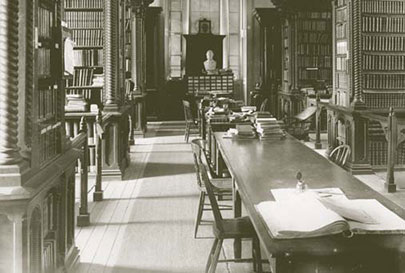
McGill University Library circa 1885
McGill University Archives
Osler championed the notion of bedside teaching, taking students along with him on his hospital rounds, so that they could witness his interactions with patients firsthand instead of relying on lectures or textbooks alone.
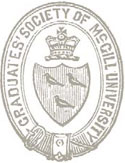
Graduates' Society of McGill University coat of arms circa 1850 -1885
John Henry Walker/McCord Museum
Still, Osler was hardly dismissive of book learning — he wrote The Principles and Practice of Medicine, which remained the most influential medical textbook for almost 50 years. "To study the phenomenon of disease without books is to sail an uncharted sea, while to study books without patients is not to go to sea at all," he once wrote.
Osler was an enthusiastic book collector himself — he would bequeath his collection of 8,000 volumes, many of them quite rare, to McGill. The Graduates' Society redoubled its efforts to boost the University's library holdings in the wake of Osler's involvement with the group, and between 1878 and 1890, the school library's collection rocketed from 5,000 to 13,000 volumes.
Admirable alumnae
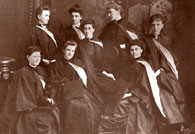
McGill's first female graduates in 1888
McGill University Archives
As the 19th century came to a close, the reach of the Graduates' Society grew as McGill alumni extended their influence outside Montreal. Beginning in 1895, Graduates' Society chapters were established in Ottawa, New York, Halifax, Toronto and British Columbia. An important new addition sprang up closer to home with the establishment of the Alumnae Society in 1889.
McGill began admitting women undergraduates in 1884, and when the first class of eight graduated four years later, these trailblazers vowed to maintain their connection to the University and promote McGill's spirit of leadership and activism in the world at large. In 1891, the Alumnae Society helped establish the Girls Club and Lunch Room, where female shop and factory workers — some of whom earned 60 cents for a 10-hour day — could buy meals for just a few pennies. Other services were added, including a fund for unemployed women, dressmaking classes, programs for children and a library.
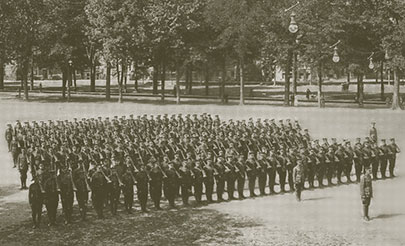
The No. 2 University Company on parade in 1915
From R.C. Fetherstonhaugh's McGill University at War
The Alumnae Society also championed women's suffrage. Although Canadian women were granted the right to vote by the federal government following the First World War, it wasn't until 1940 that women in Quebec received the vote. McGill alumnae joined their franco-phone sisters in the battle for equal rights, employing such tactics as dropping leaflets from airplanes.
The society still exists today, known now as the McGill Women's Alumnae Association. Its activities include the Muriel V. Roscoe Lecture Series (speakers have included Sheila Copps and Elizabeth May), Alumnae Scholarships and — in collaboration with the Women Associates — the annual two-day McGill Book Fair, a can't-miss event for Montreal bibliophiles.
While the Graduates' Society played an important role during McGill's early years, the organization was thrust into the national spotlight when the First World War began in August 1914. Principal William Peterson was in England at the time and the University was out of session for the summer. The Graduates' Society wrote to Prime Minister Robert Borden, offering their assistance in the Canadian war effort.
Borden responded with a call for McGill to put together a battalion. Within a matter of weeks the Society raised $25,000 for uniforms and equipment. By October 1, members of the McGill Provisional Battalion were standing shoulder-to-shoulder on the lower campus for an inspection by the Governor-General.
The Graduates' Society ensured that the soldiers were outfitted and trained with such speed that they were the first provisional unit to be presented on parade in Canada. The unit formed the University's initial wave of volunteers, a commitment that would ultimately result in 3,059 McGill men and women serving the war effort and 363 sacrificing their lives.
Molson makes his mark

Percival Molson
William Notman and Son/McCord Museum
Among McGill's recruits was Percival Molson, BA1901. Handsome, well-liked and unfailingly decent, Molson epitomized the promise of a generation that would be decimated by the war. At 16 he had been a member of hockey's Stanley Cup-winning team, the Montreal Victorias, and at McGill was named "Best All-Around Athlete" three years in a row, a feat unmatched in the University's history. After graduating, he became the youngest person ever named to McGill's Board of Governors and later served for two years as a Graduates' Society vice-president.
In May 1914, the former star athlete began raising money for a new McGill stadium. When the war started, Molson was quick to enlist and he was fighting in Europe when the McGill Graduates' Stadium opened in October 1915. He was severely wounded in Belgium in 1916 and was awarded the Military Cross for gallantry. Although it took a year to recover from his injuries, Molson insisted on returning to the front. He was killed in action just a few weeks later. A $75,000 bequest in his will paid off the stadium's remaining construction costs. Fittingly, the complex was renamed in his honour.
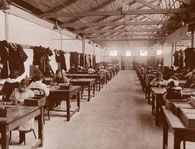
Women working in a Montreal factory circa 1914
Blake and Bennett/McCord Museum
One of the Graduates' Society's most enduring creations was launched in December 1919, when the first issue of the McGill News was published. Over the course of the next 88 years, the magazine would pick up dozens of awards. Stephen Leacock himself was on board for the magazine's first edition, serving as the head of its editorial committee.
Victorious homecoming
In 1921, the magazine summoned graduates back to their alma mater for what was originally dubbed the "Victory Reunion." Organized by the Graduates' Society, this first Homecoming also marked the centenary of the University's founding in 1821. Alumni from around the world flooded back to Montreal.
The weekend's most important event was a general meeting called by the Graduates' Society, where Principal Sir Arthur Currie addressed the graduates. A remarkable 3,000 alumni — nearly half of all living graduates at the time — filled the downtown Capitol Theatre.
The Graduates' Society remained keen to serve, and in the early 1930s, alumni approached Principal Currie, offering to undertake "some definite work that was needed by the University." Currie believed that McGill's most pressing need was for a gymnasium, but there was no money to build it. He asked the group to take on the task of developing plans and raising the necessary funds. In 1936, the $350,000 fundraising campaign began. This amount would build an armoury, gym and other related facilities. As the campaign wore on, the financial target fell short due to the lingering hardships of the Depression. An unused bequest from Lady Strathcona, donated 20 years earlier, was put toward its original purpose of building an armoury. In 1939, construction began on the gymnasium — named in honour of Sir Arthur, who died in 1933 — a project that had been called for since the late 1800s.
During the Second World War, McGill students, faculty, staff and graduates again answered the call to bear arms for their country. In total, 6,298 McGill men and women served with the Armed and Auxiliary Forces, of whom 287 lost their lives. As with the First World War, the Graduates' Society felt a responsibility to recognize and support McGill's contribution to the war effort. The McGill News was sent to all alumni serving overseas and each issue carried a section called "On His Majesty's Service," containing reports of McGill personnel on active duty.
The most important component of the Society's response to the war effort was the War Memorial Campaign, intended to create a monument to those who served and to provide a facility that would enhance campus life for student-veterans.
By train or by plane
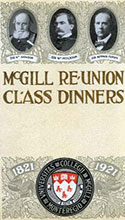
Program cover for the Victory Reunion in 1921
McGill University Archives
The three-year campaign nearly doubled its original goal, raising over $750,000 for the addition of a memorial swimming pool at the Currie Gym. Money poured in from as far away as Africa and South America. A group in England, unable to send money out of post-war Britain, purchased and shipped tiles for the swimming pool.
Graduates' Society president Eric Leslie, BSc(Eng)'16, LLD'61, ran the campaign out of Canadian Pacific Railway's offices at Windsor Station (where Leslie worked as CPR's vice-president and comptroller). Travelling in his personal railway car to 28 different cities, Leslie would invite graduates to drop by for an after-work drink in his specially equipped railcar, where he would sweet-talk many into making a donation or assisting the campaign in some other fashion.
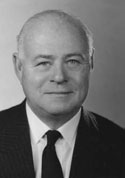
E.P. Taylor
McGill University Archives
This wouldn't be the last time that a McGill graduate employed such unorthodox techniques to raise funds for his alma mater. Having established the Alma Mater Fund in 1948, Canadian business tycoon E.P. Taylor, BSc'22, LLD'77, then crisscrossed the continent in his Grumman Mallard amphibious plane to drop in on 31 alumni branches to solicit donations. The Alma Mater Fund's kickoff was noted in the McGill News with a plea to graduates from Taylor, explaining that small annual donations served the same function as the yearly interest from a large, one-time gift — which only a few could make. By giving a little each year, he famously wrote, graduates could serve the University as "a living endowment."
His reasoning hit home. In its first year, the Alma Mater Fund set a North American fundraising record, collecting over $137,000 and helping the University cope with a post-war boom that saw enrolment balloon by 150 per cent while sources of funding shrank.
Taylor's scheme has continued to connect with graduates ever since. Last year, the fund received more than $6.3 million.
When the fur really flew
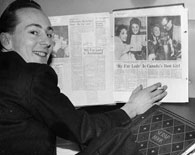
My Fur Lady co-creator James Domville with newspaper clippings about his hit musical
McGill University Archives
In the 1950s, the Graduates' Society ventured into show biz, helping transform a student musical into a national phenomenon. The annual McGill Red and White Revue, usually a tepid imitation of a Broadway musical, was turned on its ear in 1957 by law students Tim Porteous, BA'54, BCL'57, James Domville, BA'54, BCL'57, Donald MacSween, BA'56, BCL'61, and Erik Wang, BA'54, BCL'57. Their wildly successful My Fur Lady was a witty satire that poked fun at Prime Minister Louis St. Laurent's smug Liberals, Quebec's puritanical approach to censorship, academic life at McGill and the latest singing sensation, Elvis Presley.
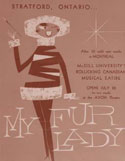
A 1957 publicity poster for My Fur Lady
McGill University Archives
Choreographer Brian Macdonald, BA'54, and former music student Galt MacDermot also played pivotal roles in the production and many of My Fur Lady's key creators went on to prominent careers in the arts — MacDermot, for instance, composed the music for the Broadway smash Hair, Macdonald went on to become an internationally renowned choreographer and MacSween became the general director of the National Arts Centre.

McGill's jazz band performing in Britain in 1992
Sidney Harris
The original seven-night run on campus was such a success that the musical eventually snowballed into an 18-month, cross-Canada tour. But not without the help of the Graduates' Society and its business-savvy executive secretary, Lorne Gales, BA'32, BCL'35, LLD'79, a strong supporter of the show from the outset. Gales committed the society to a $4,000 guarantee against losses so that My Fur Lady could enjoy a second, longer run the following summer. When this was a success, Gales sought a further $5,000 to take My Fur Lady to the Stratford Festival. The support came from six alumni "angels," including E.P. Taylor. The show was eventually seen by more than 400,000 people and grossed $900,000 — a staggering amount for that time.
The Alumni Association would go on to support many subsequent student ventures. Perhaps the most ambitious took place in the fall of 1992, when the Graduates' Society organized a European tour for the University's award-winning 22-piece jazz band.
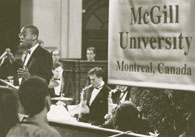
The Graduates' Society released recordings of such songs as "Hail Alma Mater" in 1958
McGill University Archives
Students who took part in that tour are now among Canada's top jazz talents, including vocalist Denzel (Pinnock) Sinclaire, BMus'93, and saxophonists Joel Miller, BMus'93, and Christine Jensen, BMus'94, MMus'06. A TV audience of three million watched the group perform on Ireland's The Late, Late Show.
At the service of students
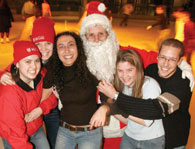
The McGill Alumni Association sponsors the International Students' Skating Party
Owen Egan
In recent years, the MAA has put even more effort into programs and services that target the needs of McGill students. For instance, the MAA organized hometown send-offs for new McGill students in 37 different locations this year, including New York, San Francisco, Paris, New Delhi, Hong Kong and Cairo. Incoming frosh get the chance to meet other new students so they'll know a few friendly faces once they get to Montreal. Also invited are alumni, current students and MAA staff who soothe last-minute jitters and answer questions from students and parents about the University and the city.
The MAA collaborates with McGill's Career and Placement Services in organizing a mentorship program that puts students in touch with McGill grads who are working in fields that pique the students' interests. While students are on campus, the MAA provides financial support for a variety of student-run projects, clubs and sports teams, and MAA staff help organize events and assist students with their own fundraising campaigns.
The MAA's month-long "Backpack to Briefcase" lecture series, offered to students in the spring, provides invaluable tips for post-graduation living. Lectures deal with everything from managing finances to putting together wardrobes and proper dining etiquette. In all, MAA activities served the needs of about 12,000 students last year.
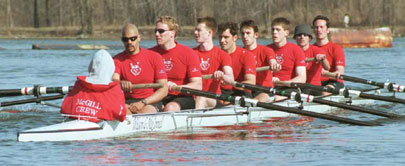
The McGill Alumni Association supports a wide range of student clubs, including the McGill University Rowing Team
Hungering for brain food
The MAA has also shifted its focus in recent years in terms of the services it provides to graduates.
"People now are so busy, they don't just want to come out for a social event. If they are going to come to the University for something, it has to have some intellectual content," says Vroom.
The MAA has co-sponsored the award-winning "Mini" series since 2001, a wildly popular public lecture series featuring some of the University's top researchers in management, medicine, music and science, all offering up their jargon-free expertise to audience members who range from high school students to retirees. More recently, the MAA's McGill Reads Book Club has been presenting some of the University's leading literary scholars dissecting the works of such authors as Alice Munro, Raymond Chandler and Jane Austen.

MAA staffers are on duty each autumn in the McGill Parents Tent to answer queries from the parents of new McGill students
Claudio Calligaris
Some things haven't changed much over the years. The MAA still dedicates itself to the task of keeping McGill graduates in touch with the University and with one another. Homecoming, the MAA's signature event, regularly attracts 4,000 graduates back to the downtown and Macdonald campuses each year. The McGill Alumni Online Community has signed up more than 25,000 members since its launch in 2004. Its site (www.alumni.mcgill.ca) offers graduates email addresses for life, helps them connect with former classmates and provides information about upcoming McGill events.
Alumni are invaluable allies for the University, says Chancellor Richard Pound, BCom'62, BCL'67, a former MAA president. "You would expect your principal and the staff to speak on behalf of the University, because they're paid to do that. The folks who have been through the institution and still support it are that much more credible."
That credibility sometimes extends to criticisms about the University itself.
"If you've been working at McGill as long as I have, you can lose your objectivity," says senior development advisor Tom Thompson, BSc(PE)'58, MEd'78, who has been working with McGill graduates for more than three decades. "I believe that alumni have an objectivity when they look at the University. They can ask the question, 'Why doesn't McGill do this?'"
Shaughnessy agrees. "Maybe they're our litmus test, in a way, of how well we're doing."
While the MAA can take pride in its many accomplishments over the past 150 years, there is no time to get relaxed about it, insists Vroom.
"There's a huge family out there, and there is a huge untapped reservoir of good will. We need to constantly be looking for ways to bring more of that good will into McGill."
A proud McGill graduate himself, Brett Hooton spends his days as a communications officer for his alma mater and his evenings as the theatre columnist for the Montreal cultural weekly, Hour. Born and raised in Kansas City, Missouri, he has written for a wide range of print and online media, including the Kansas City Star and the Montreal Gazette.


